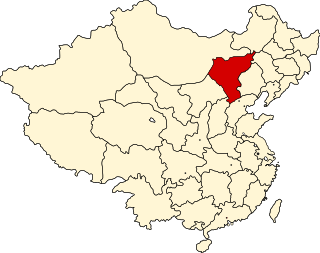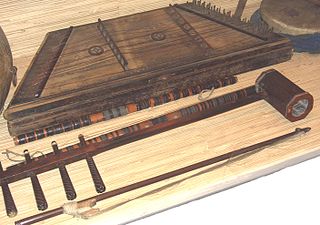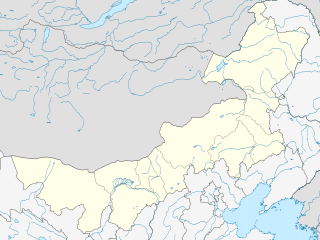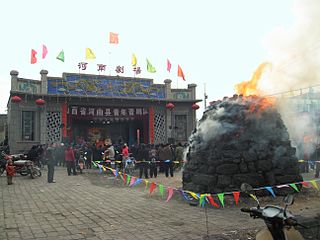Related Research Articles

Inner Mongolia or Nei Mongol, officially the Inner Mongolia Autonomous Region, is a Mongolic autonomous region in Northern China. Its border includes most of the length of China's border with Mongolia. The rest of the Sino–Mongolian border coincides with part of the international border of the Xinjiang autonomous region and the entirety of the international border of Gansu province and a small section of China's border with Russia. Its capital is Hohhot; other major cities include Baotou, Chifeng, Tongliao, and Ordos.

Hebei is a coastal province in Northern China. The modern province was established in 1911 as Chihli Province. Its capital and largest city is Shijiazhuang. Its one-character abbreviation is "冀" (Jì), named after Ji Province, a Han dynasty province (zhou) that included what is now southern Hebei. The name Hebei literally means "north of the river", referring to its location entirely to the north of the Yellow River.

Syringa (lilac) is a genus of 12 currently recognized species of flowering woody plants in the olive family (Oleaceae), native to woodland and scrub from southeastern Europe to eastern Asia, and widely and commonly cultivated in temperate areas elsewhere.

Chahar, also known as Chaha'er, Chakhar, or Qahar, was a province of the Republic of China in existence from 1912 to 1936, mostly covering territory in what is part of eastern Inner Mongolia. It was named after the Chahar Mongolians.

Qinqiang or Luantan is the representative folk Chinese opera of the northwest Province of Shaanxi, China, where it was called Qin thousands of years ago. Its melodies originated from rural areas of ancient Shaanxi and Gansu. The word itself means "the tune or sound of Qin."

Jin is a group of Chinese dialects or languages spoken by roughly 63 million people in northern China. Its geographical distribution covers most of Shanxi province except for the lower Fen River valley, much of central Inner Mongolia and adjoining areas in Hebei, Henan, and Shaanxi provinces. The status of Jin is disputed among linguists; some prefer to classify it as a dialect of Mandarin, but others set it apart as a closely related, but separate sister-language to Mandarin.

Adenophora is a genus of flowering plants in the family Campanulaceae, the bellflowers. Plants of this genus are known commonly as ladybells. Most are native to eastern Asia, with a few in Europe. Many are endemic to either China or Siberia.

The sihu is a Chinese bowed string instrument with four strings. It is a member of the huqin family of instruments.

Leonurus is a genus of flowering plants in the family Lamiaceae. It is native to Europe and Asia, naturalized in New Zealand, Hawaii, New Caledonia, and much of North and South America.

The Hebei–Chahar Political Council, or Hebei-Chahar Political Commission, was established at Beijing under Gen. Song Zheyuan, 1935-12-08.
Shan'ge is a genre of Chinese folk song. They are commonly sung in rural provinces; the word "Shan'ge" means "mountain song".
Gucheng, formerly romanized as Ku Ch'eng, may refer to the following places in China:

Xinghe County is a county of south-central Inner Mongolia, People's Republic of China, bordering the provinces of Hebei to the east and Shanxi to the south. It is under the administration of Ulaan Chab City, and is situated on the China National Highway 110 between Ulaan Chab and Zhangjiakou in Hebei province. Bordering county-level divisions include Fengzhen City to the southwest, Chahar Right Front Banner to the west, Chahar Right Back Banner to the northwest, and Shangdu County to the north.
Hebei bangzi (河北梆子) is a genre of Chinese opera from the northern province of Hebei. It may also be found in the nearby cities of Beijing and Tianjin, as well as in Shandong, Henan, Heilongjiang, Jilin, Liaoning, and Inner Mongolia, as well as some areas south of the Yangtze River such as Shanghai and Wuhan.
Bingzhou, or Bing Province, was a location in ancient China. According to legend, when Yu the Great tamed the flood, he divided the land of China into the Nine Provinces. Historical texts such as the Rites of Zhou, and "Treatise on Geography" section of the Book of Han, recorded that Bingzhou was one of the Nine Provinces. Bingzhou covered roughly the areas around present-day Baoding, Hebei, and Taiyuan and Datong in Shanxi.
Chaodaogou culture was a late Bronze Age nomadic archeological culture in the northern Hebei, Shanxi, Shaanxi, and Henan provinces of China, its center is located between the bend of the river Hunahe and the drainage basin of the Liao 遼/辽 river. Chaodaogou culture is cautiously dated to c. the 9th to 8th centuries BCE, falling within Western Zhou period of the Central Plain (Zhongyuan) area. The type site of the culture is Chaodaogou in Qinglong county, Hebei, excavated in May 1961. Another typical site of this culture is a cemetery in Linzheyu (林遮峪) in Baode county, Shaanxi. The Chaodaogou culture is roughly contemporary with the fishing and hunting nomadic Baijinbao culture in Heilongjiang.

In 2001, the Institute of Archaeology of the Chinese Academy of Social Sciences organized a poll for China's 100 major archaeological discoveries in the 20th century. The participants included eight national-level institutions for archaeology and cultural relics, provincial-level archaeological institutes from 28 provinces, municipalities, and autonomous regions, as well as from Hong Kong, the archaeological departments of 11 major national universities, and many other scholars in Beijing. After three months and three rounds of voting, the results were announced on 29 March 2001 and were published in the journal Kaogu (Archaeology). In 2002, the Chinese Academy of Social Sciences Press published the book China's 100 Major Archaeological Discoveries in the 20th Century (二十世纪中国百项考古大发现), with more than 500 pages and 1,512 pictures.

Shanxi opera, or Jin opera, is the major Chinese opera form in the province of Shanxi. Shanxi opera developed in central Shanxi during the Qing dynasty, by incorporating local rice-planting song styles into Puju, a related genre from southern Shanxi. In the early 20th century, the popularity of Shanxi opera spread into other provinces like Hebei, Shaanxi, Gansu, and Inner Mongolia, thanks to the dominance of Shanxi merchants in Chinese trade.
References
- ↑ Ye, Tan (2008). Historical Dictionary of Chinese Theater. The Scarecrow Press. p. 340. ISBN 978-0-8108-5514-4.
- ↑ "Errentai of Kangbao County". Zhangjiakou Tourism Development Committee. 2015-05-28.
- 1 2 3 Gibbs, Levi S. (2018). Song King: Connecting People, Places, and Past in Contemporary China. University of Hawaiʻi Press. p. 52. ISBN 9780824869908.
- 1 2 3 4 "Errentai Opera". China Daily . 2015-10-29.
| This Chinese music article is a stub. You can help Wikipedia by expanding it. |